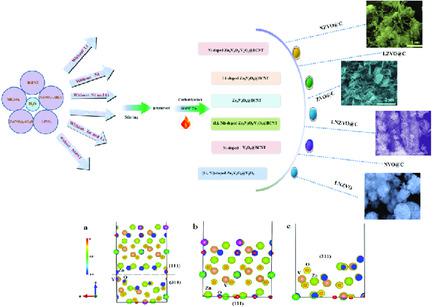当前位置:
X-MOL 学术
›
Energy Technol.
›
论文详情
Our official English website, www.x-mol.net, welcomes your feedback! (Note: you will need to create a separate account there.)
Matched Facet-Induced Microflower-Like Li, Ni-Codoped Zn3V3O8/V2O3 Nanoplate Assemblies Grown on Bamboo-Like Carbon Nanotube for High Energy Density Lithium-Ion Capacitors
Energy Technology ( IF 3.8 ) Pub Date : 2020-09-26 , DOI: 10.1002/ente.202000701 Youcun Bai 1 , Yang Hai 1 , Leilei Cui 1 , Yun Gong 1
Energy Technology ( IF 3.8 ) Pub Date : 2020-09-26 , DOI: 10.1002/ente.202000701 Youcun Bai 1 , Yang Hai 1 , Leilei Cui 1 , Yun Gong 1
Affiliation

|
Herein, Li, Ni-codoped Zn3V3O8/V2O3@bamboo-like carbon nanotube (BCNT) is synthesized as an anode for a Li-ion capacitor (LIC), which exhibits a high capacity and excellent cycling stability. The capacity retention is 91.0% after 2000 cycles at 5 A g−1. Meanwhile, the formation mechanism of the hierarchical morphology of LNZVO@C is investigated. It is expected that the formation of Zn3V3O8/V2O3 nanoplates is based on their matched d spacings, d(311)(Zn3V3O8) ≈ d(110)(V2O3). The lateral and radial (thickness) directions of the nanoplate are along Zn3V3O8 (311) and (111) facets, respectively. Density functional theory (DFT) calculations reveal that the Zn2VO4 (311/111) heterointerface is thermodynamically favorable, and its good stability is associated with the charge transfer from the V atoms on the (111) surface to the V atoms on the (311) surface. Although the existence of ZnV2O4 phase is not beneficial for the formation of ZnV2O4 (311)/(111) interface, it favors the improvement of electron conductivity. Meanwhile, a KOH-activated BCNT is designed as the cathode for LIC, which shows a relatively high capacity. The LNZVO@C//FBCNT LIC with carbon nanotube–derived cathode and anode can provide high energy densities.
中文翻译:

在竹状碳纳米管上生长的匹配小面诱导微花状锂、镍共掺杂 Zn3V3O8/V2O3 纳米板组件,用于高能量密度锂离子电容器
在此,Li、Ni共掺杂的Zn 3 V 3 O 8 /V 2 O 3 @竹状碳纳米管(BCNT)被合成为锂离子电容器(LIC)的阳极,具有高容量和优异的循环稳定。在 5 A g -1 下循环 2000 次后容量保持率为 91.0% 。同时,研究了LNZVO@C分层形态的形成机制。预计 Zn 3 V 3 O 8 /V 2 O 3纳米片的形成是基于它们匹配的d间距,d (311) (Zn 3 V3 O 8 ) ≈ d (110) (V 2 O 3 )。纳米板的横向和径向(厚度)方向分别沿着 Zn 3 V 3 O 8 (311) 和 (111) 面。密度泛函理论 (DFT) 计算表明,Zn 2 VO 4 (311/111) 异质界面在热力学上是有利的,其良好的稳定性与电荷从 (111) 表面上的 V 原子转移到表面上的 V 原子有关。 (311) 表面。虽然ZnV 2 O 4相的存在不利于ZnV 2 O 4的形成(311)/(111)界面,有利于提高电子电导率。同时,KOH 活化的 BCNT 被设计为 LIC 的阴极,显示出相对较高的容量。具有碳纳米管衍生的阴极和阳极的 LNZVO@C//FBCNT LIC 可以提供高能量密度。
更新日期:2020-09-26
中文翻译:

在竹状碳纳米管上生长的匹配小面诱导微花状锂、镍共掺杂 Zn3V3O8/V2O3 纳米板组件,用于高能量密度锂离子电容器
在此,Li、Ni共掺杂的Zn 3 V 3 O 8 /V 2 O 3 @竹状碳纳米管(BCNT)被合成为锂离子电容器(LIC)的阳极,具有高容量和优异的循环稳定。在 5 A g -1 下循环 2000 次后容量保持率为 91.0% 。同时,研究了LNZVO@C分层形态的形成机制。预计 Zn 3 V 3 O 8 /V 2 O 3纳米片的形成是基于它们匹配的d间距,d (311) (Zn 3 V3 O 8 ) ≈ d (110) (V 2 O 3 )。纳米板的横向和径向(厚度)方向分别沿着 Zn 3 V 3 O 8 (311) 和 (111) 面。密度泛函理论 (DFT) 计算表明,Zn 2 VO 4 (311/111) 异质界面在热力学上是有利的,其良好的稳定性与电荷从 (111) 表面上的 V 原子转移到表面上的 V 原子有关。 (311) 表面。虽然ZnV 2 O 4相的存在不利于ZnV 2 O 4的形成(311)/(111)界面,有利于提高电子电导率。同时,KOH 活化的 BCNT 被设计为 LIC 的阴极,显示出相对较高的容量。具有碳纳米管衍生的阴极和阳极的 LNZVO@C//FBCNT LIC 可以提供高能量密度。



























 京公网安备 11010802027423号
京公网安备 11010802027423号